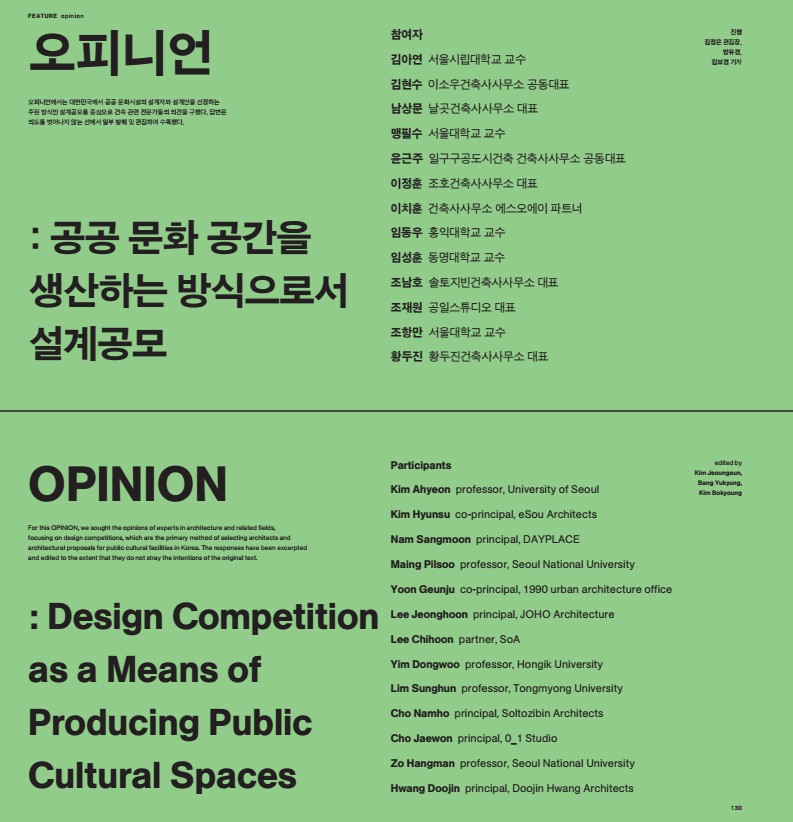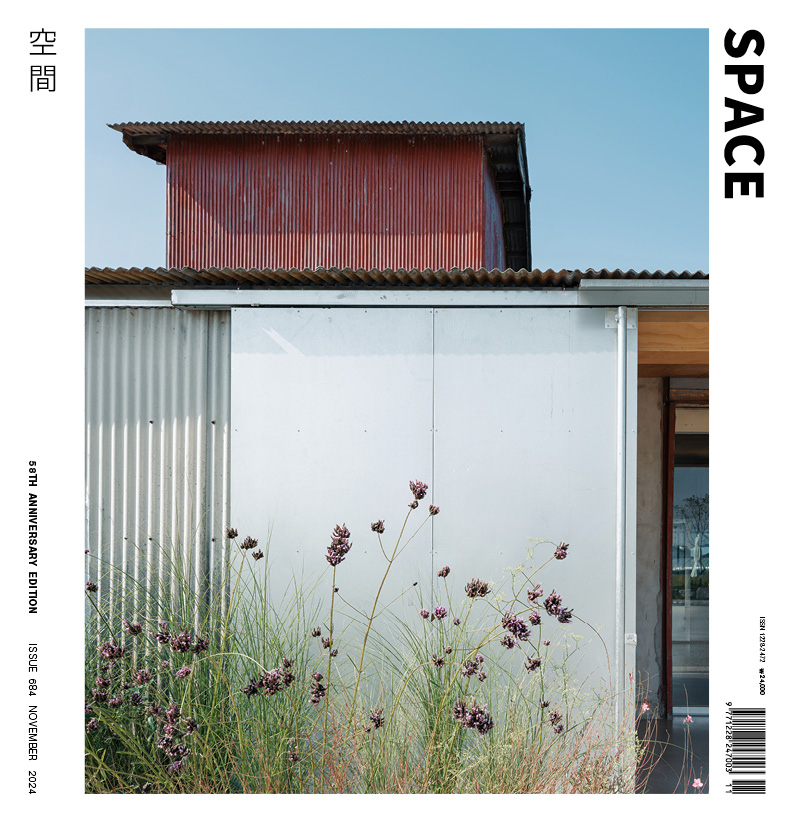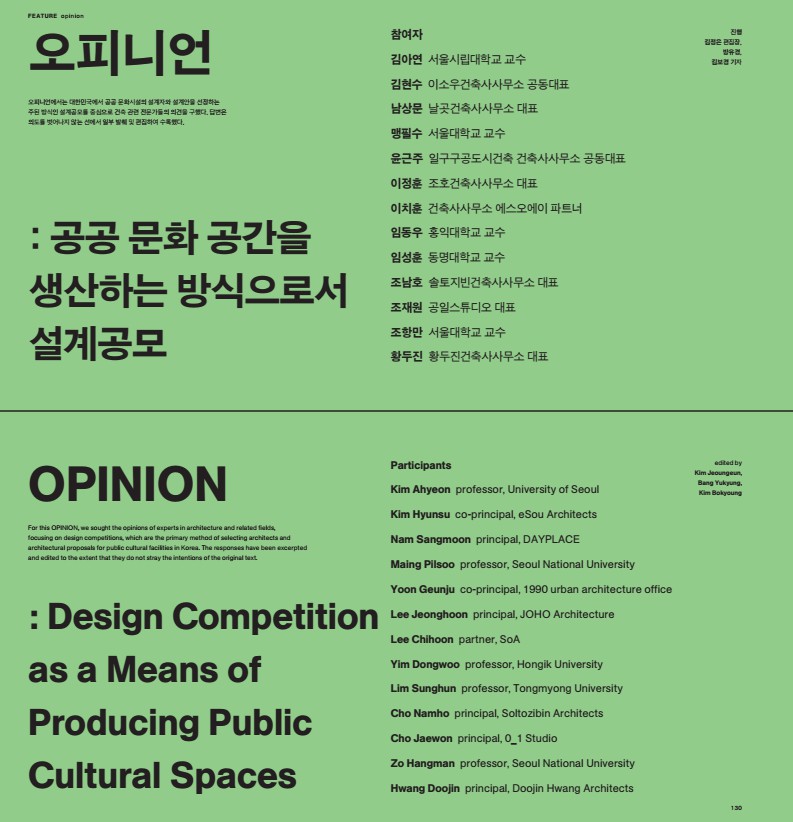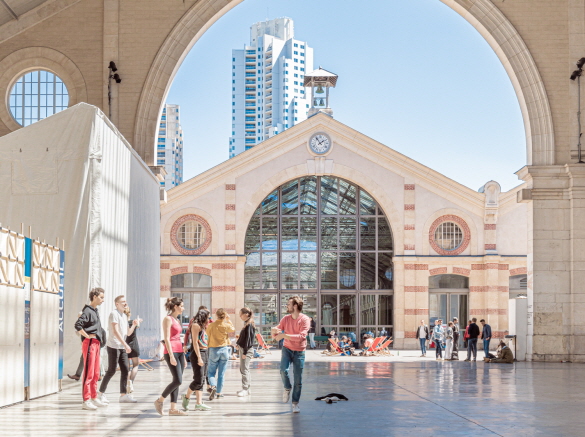SPACE November 2024 (No. 684)

For this OPINION, we sought the opinions of experts in architecture and related fields, focusing on design competitions, which are the primary method of selecting architects and architectural proposals for public cultural facilities in Korea. The responses have been excerpted and edited to the extent that they do not stray the intentions of the original text.
Participants
Kim Ahyeon professor, University of Seoul
Kim Hyunsu co-principal, eSou Architects
Nam Sangmoon principal, DAYPLACE
Maing Pilsoo professor, Seoul National University
Yoon Geunju co-principal, 1990 urban architecture office
Lee Jeonghoon principal, JOHO Architecture
Lee Chihoon partner, SoA
Yim Dongwoo professor, Hongik University
Lim Sunghun professor, Tongmyong University
Cho Namho principal, Soltozibin Architects
Cho Jaewon principal, 0_1 Studio
Zo Hangman professor, Seoul National University
Hwang Doojin principal, Doojin Hwang Architects
Q1.
Who produces and enjoys public cultural spaces? Who in our society is being included or excluded from the public cultural spaces created today?
Yim Dongwoo Korean architecture holds these two terms as absolute ‘good’: public and culture. I often teach my students to be careful when using these terms. There is a general tendency to think that any architecture that uses these terms is ‘good architecture’. The term public, not to mention culture, however, is not always neutral in terms of being inclusive to certain classes and exclusive to others. This was the case with Central Park in New York City as well as with the restoration project of Cheonggyecheon Stream in Seoul. We can always ask ourselves if there was truly no one being excluded from these supposedly successful public projects. Ultimately, it boils down to the question of how one delimits publicness and cultural space.
Lee Chihoon While public cultural space is meant for everyone, the decision-making process and the technology behind its production are dictated by a few professional urban architects. It is undeniable that the people who should be enjoying these spaces are excluded from the process of producing these public cultural spaces.
Nam Sangmoon In the case of cultural spaces outside of Seoul, they are one-sidedly supplied by the local governments in a short space of time. However, the cultural life that people enjoy is not limited to luxury or high-end cultural activities, but also includes content and cultural spaces comprised of various subcultures. Here lies the reason for the cultural gap between the urban and the rural. Because the supply of cultural spaces in the rural areas tends to focus mostly on high-end cultural facilities, problems such as exclusion and isolation of various social constituents and production inefficiency and incongruity caused by rigid bureaucratic practices continue to arise.
Lim Sunghun In areas outside of Seoul, especially in Busan, public cultural spaces are produced by the local municipality or some member of the parliament. They are not cultural spaces for the masses but political achievements covered up as ‘attractions’. Location was a common problem for the Museum of Contemporary Art Busan, Busan Metropolitan Library, and Busan Opera House. It was also the same for Busan Cinema Center. During its design competition, the site of the Busan Cinema Center which hosts the Busan International Film Festival was switched from the old city centre to Busan’s Centum City which was a newly developed site at that time. The central area of the film festival was changed in line with an overarching political agenda in order to procure certain results from the development policy. The same happens in Seoul. Was there no political agenda behind the restoration of Cheonggyecheon Stream and Dongdaemun Design Plaza (DDP)? The most important spaces are still owned by those in power. As long as the production process continues to stay in their hands, the wider public will remain excluded from the things that matter most even when it appears as though they are the ones occupying and enjoying those spaces.
Maing Pilsoo I believe that in a developed society, its people should produce and enjoy culture. But in recent examples of public cultural spaces, it seems as though the decision-making parties are focused more on the tourists than on the locals and are favoring landmarks with strong impressions rather than places for daily enjoyment.
Q2.
Are landmarks for tourists and locals the same?
Yim Dongwoo Landmarks in all places of the world and at every stage of history have existed for both locals and foreigners. Landmarks are one of the necessary components of a city. The question then is how much importance should we place on landmarks when working on public projects. Also, we need to ask ourselves how we should define landmarks today as we approach the second half of the 21st century.
Nam Sangmoon According to the Seoul Survey, most people consider the old palaces and the natural environment surrounding the old city centre as Seoul’s landmarks. But the Seoul Metropolitan Government (SMG) has been focusing on developing large-scale landmarks that would also function as part of the tourism infrastructure such as Nodeul Island, Seoul Ring, and the 2nd Sejong Center for Performing Arts. Most bureaucrats see landmarks as visual attractions or unique sensational experiences. They also claim that landmarks are necessary for urban economic growth, but they do not clarify what they mean exactly by landmarks, nor do they explain who the beneficiaries of these urban economic growth are. Too many development projects are happening all at once without sufficient public discussion to understand how these landmarks affect people’s lives.
Zo Hangman When it comes to attracting attention, there is no significant difference between a landmark for tourists and a landmark for locals. But while landmarks serve as small getaways for locals from their monotonous lives, however, for tourists, landmarks are once-in-a-lifetime opportunities for exotic and special experiences. Also, unlike locals, tourists are not responsible for preserving and maintaining these landmarks. Consequently, tourism-focused landmarks can easily turn into something disruptive to the locals’ lives. While there are not many examples, however, landmarks where both tourists and locals thrive tend to be naturally created landmarks born out of age-old cultural traditions rather than landmarks that were artificially created over a short period of time.
Cho Namho Publicly created cultural spaces are heterotopian urban spaces in the sense that they are not completely mundane. This applies even more so to iconic cultural spaces that have commemorative qualities. Even if these facilities were to be designed with public participation, they tend to end up as either spaces for a specific class of people or tourists. As one of Zaha Hadid’s masterpieces, DDP is a facility that is functioning well in accordance with the original design intention, however, on the premise that ‘fairness’ is one of the core virtues of a good city, it is also important to remind ourselves of how the rights of numerous people who used that space daily were overlooked to make DDP a reality. Paradoxically, the possibility of new architecture is often an intrinsic feature of heterotopia. Fair architecture where commemorative cultural space coexists with everyday life demands high-quality planning and design.
Q3.
How can people’s wishes be reflected in public cultural spaces?
Yim Dongwoo While one is free to criticise the methods used to gather public opinion or the lack of it, what we should also do is to take a step back and ask if the project is even necessary in the first place. Perhaps because of the mutually dependent relationship between the public and architectural scene in Korea, I can hardly recall a case where the architectural scene took the initiative to question the need for a public project on the grounds that it is not reflective of public opinion. We gloss over such questions because projects make our livelihood. It might be obvious, but to properly reflect public opinion, we need to slow down our decision-making. What point is there to ask for people’s opinions after already making the decision ourselves to start the project? We must acknowledge that it can take years to truly grasp what the people want. Even if that means earning less.
Nam Sangmoon In a democratic society, public opinion is crucial. However, public opinion is not everything. The government, civic society, and professionals must clearly recognise their respective roles and responsibilities and learn to cooperate with one another from a place of mutual respect. In reality, differing opinions and demands may arise not only among civic societies but also among professionals. Government policies also change rapidly whenever a new party takes over. Today, public opinion and professionals are powerless. This is not because of lack of communication, but due to the lack of an established social norm, the roles of professionals and people are not clearly defined in public projects. Things are polarised between civic society and architects: the former perceives the latter as labour while the latter claim that they are being asked to donate their talents to society. While some professional organisations might step in to mediate between governmental and civic bodies, however, because of a generally low trust toward professionals in our country, these interventions sometimes worsen the conflict. Architects should also learn to rely less on moralising expectations when building their narratives around ‘publicness’. Professionals can maintain their professional footing when they are proportionately remunerated for their social contributions, and it is only then that we can expect a citizen-to-citizen dialogue to take place.
Kim Hyunsu During the process of creating public cultural space, attempts are made to raise public interest and trust by making the jury and the review process of design competitions public. However, a capable system that can collect and reflect opinions of the entire design competition process is yet missing. What is even more problematic is the reckless public complaints that have caused schedule delays and compromise of design intents and have thereby contributed to increased hesitancy toward the integration of public opinion. As an example, upon receiving complaints from the resident community and the public, Suncheon Art Platform: The Hidden Cloister (covered in SPACE No. 669) responded to those opinions by adding a new parking lot and installing additional elevators that connect to the nearby underground shopping complex. However, another complaint arose regarding the installation of the café right at the final construction stage, and this led to the revising the usage of the café and amenities into a multipurpose study hall due to insufficient time to contemplate other options. This made it difficult for the park and the plaza to become quotidian spaces. Design competition projects have official administrative protocols. If competitions were to be disclosed for public engagement in a stage-by-stage manner while abiding by these protocols, it would ensure a timely collection of various public opinions and a result that is convincingly reflective of those opinions.
Maing Pilsoo It might sound naïve, but one can imagine an ideal world where politicians forgo their personal ambitions and, instead of devaluing their predecessor’s work for self-promotion, conscientiously succeed and complete those projects according to proper procedures.
Lee Jeonghoon While it would be preferable to carry out multiple public debates and surveys to collect public opinions on projects that specifically need to demonstrate their outreach, when dealing with projects of a more multifaceted nature, professional opinions might be more important when considering their broader range of expertise. A more plastic system that can cater to general and professional opinions according to project direction and purpose is needed. Reducing the operations of every individual project into just one standardised framework known as ‘publicness’ can also be problematic.
Lee Chihoon While public hearings are often only used to secure procedural legitimacy for plans that have already been finalised, it would be ideal if they were to be used instead as platforms to hold productive discussions regarding what the public communities aspire toward and value in terms of the city and architecture. It would be something like a division of roles between the masses and professionals.
Lim Sunghun It cannot exist if it is not followed up with some practice that binds it into being. Hence, before discussing how we might reflect public opinion, architects must first turn these public opinions into values. Take Gamcheon Culture Village in Busan as an example. This village was created artificially. It is no more special than anywhere else. While places like Ami-dong Biseok Village which was spontaneously formed by people who – having no place to live – gathered to form a community that grows crops by the graveyard is now facing threat of disappearing due to land redevelopment, Gamcheon village, on the other hand, has survived. The reason is simple. As artists moved into the village, public opinions became tangibly real and turned the village into a popular attraction in Busan.
Cho Namho The success of collecting public opinion depends on the appropriateness of motives, procedures, and duration. We need a high-standard form of governance that strives beyond a passive form of collecting opinions via fixed format surveys on a civil self-governance platform to a more active framework where people can freely make policy proposals. This would require the retrieval of citizen’s rights from the politicians. Also, one must also acknowledge that it can sometimes take more time than expected to initiate discussions that truly respect diversity of opinions and formulate future-oriented conclusions.
Zo Hangman Public funds have a fixed usable duration and scope. Few government officials would take their time to gather and research public opinion considering that public funds are liable to be recovered and the people in charge penalised if the funds are not used up within the fiscal year. Also, in Korea, where receiving donations for public projects can be a violation of the Political Funds Act, budgets for public projects tend to be tight, and public opinions are naturally relegated in terms of their priority. Look at the present Lee Kun-Hee Museum (tentative name) project underway in Songhyeon-dong, for example. The SMG and the Ministry of Culture, Sports and Tourism are competing against one another over the site, while politicians and government leaders are mostly interested in appealing to their supporters. There is a need to develop a more detailed administrative and policy support for public participation. Most public hearings, surveys, and calls for ideas thus far have been carried out in a formalistic way. If this is too much trouble from the governmental side, more support should be provided to the citizens to encourage grassroot initiatives. People-led initiatives are the only realistic way to achieve rapid improvement. However, in Korea where leading a normal life is already a tough challenge for many, having public interest reflected in public cultural space might be tougher than expected.
Hwang Doojin In the long term, I believe the urban and architecture sectors need diverse think tanks to act as bridges between public institutions and citizens. In the past, civic groups such as the Ctizens’ Coalition for Economic and Justice (CCEJ) partially fulfilled this role, but nowadays, they seem to focus more on economics, politics, and social issues. Given the characteristics of architectural academia or architectural institutions, I don't think they can adequately perform this role on their own, nor do I believe that general citizens can do so without support. In other words, our field requires new organizations based on a broad governance concept. If political bias can be excluded, such entities could even exist as part of a civic organization.
Q4.
Aside from design competitions, what should be done to ensure clear planning?
Kim Ahyeon Planning is a fundamental act of design. A system that recognises the planner’s contributions needs to be instituted. Recently, I had the opportunity to apply for an award competition for completed projects. I added a separate entry to include information of the planner to the application template form which only asked for the information of the client, designer, and constructor, and my application was returned for not abiding by the template. There are not many opportunities to credit the planner. A good space begins with a good idea. I hope that its value is rightfully appreciated.
Maing Pilsoo As per the Framework Act On Building and the Act On The Promotion Of Building Service Industry, I believe that we are sufficiently equipped with work regulations and systems to make clear plannings. However, there are cases when the design aims fail to be fully realised during the operation stage, either due to a client’s lack of understanding and impatience or frequent replacements of the operating management such as from rotation duty, and such practices should be prevented. Recently I advised a project that – because it had its budget preassigned by a certain organisation – considered planning design unnecessary. We realised that we had very different ways of thinking.
Zo Hangman A skilled architect’s design might be able to compensate for what is lacking in terms of planning. But design cannot replace planning in terms of deciding the ‘what’ and ‘where’. It is not for nothing that people often claim that what is important is the basics. What is there to design about the world’s first and tallest ‘100m flagpole at Gwanghwamun Square’ or the ‘double ring observatory in the vicinity of Nanjido’? The images and solutions proposed by architects with more pragmatic attitudes, prioritising profits above all, are prevalent.
Lim Sunghun When it comes to architectural planning, our society places greater focus on how to properly ‘distribute’ the limited resources of money and land space rather than contemplating clear ‘values’. The winner of this competition tends to invest the money and land space for an iconic architecture for one’s political ambitions, and landowners follow suit as the attraction of neighbourhood facilities lead to a rise in housing prices. Architects need to contemplate the social problem of distribution. Architects must think more deeply about this situation and produce radical alternative solutions for proper planning and production.
Cho Namho Practically speaking, planners do not have much time to spend reflecting at length as participants do. While guidelines propose and open new directions, they often pale in comparison with the imaginative power of participants that can cross into areas that are not covered by those guidelines.
Lee Chihoon Urban architectural planning is a task of defining the professional and technical conditions required for a project. While clearly conveying the philosophical direction of the project, architectural planning must be defined with minimal conditions to free it to various architectural interpretations. Also, matters of budget, programme, scale, and others should be decided under the discretion of an experienced architect.
Cho Jaewon Planning is a process of adjusting the priorities for resources, reviewing a wide spectrum of plausible scenarios, and gathering decision-making parties to a shared public forum. Good planning for public cultural space requires extensive and in-depth research regarding the potential user groups and needs, the interactions between diverse user groups, and the regional and social contexts in which the space will be located. If the guidelines of a design competition are too loose and unspecific to avoid ‘restraining the creativity of participants’, its participants cannot but carry out their own research and planning before design work. This would mean that it would be up to the discretion of the jury to choose one among the various possibilities proposed by the participants, and this creates a problem. To assume that the jury – and not the planning organisation, or the operating organisation, or the potential users – will be able to discern a ‘good’ architecture is wishful thinking based on administrative irresponsibility. Even if one had the fortune to start out with a strong plan, the process of creating a public cultural space, which should be organically continuous and unified, often ends up disconnected between planning, design, and operation due to a mechanistic emphasis on ‘fairness’. Even when a project is realised through elaborate planning and creative competition process, it may still fail to meet the conditions of actual operation or the users’ needs, or it may encounter unexpected variables in the real world. The original plan must not be discarded even after the winner gets selected and the construction gets finished. When it comes to production of public cultural space, the direction stated in the planning must be continuously practiced as the norm for that space, and so it is important that the planning’s narrative is properly transferred to the people as its new owners. I believe that this must be considered as a key performance indicator. The end goal of public cultural space is not a ‘beautiful and creative architecture’. That is only the beginning; what must follow is the creation of an urban narrative in which people participate. Planning public cultural space is merely creating a seed of a narrative; when the public cultural space is created, the architecture should be viewed as a platform for people to take ownership of its narrative and as a part of the surrounding environment. Consequently, planning is a promise of space to the people.
OPINION : Design Competition as a Means of Producing Public Cultural Spaces ② (Link)







